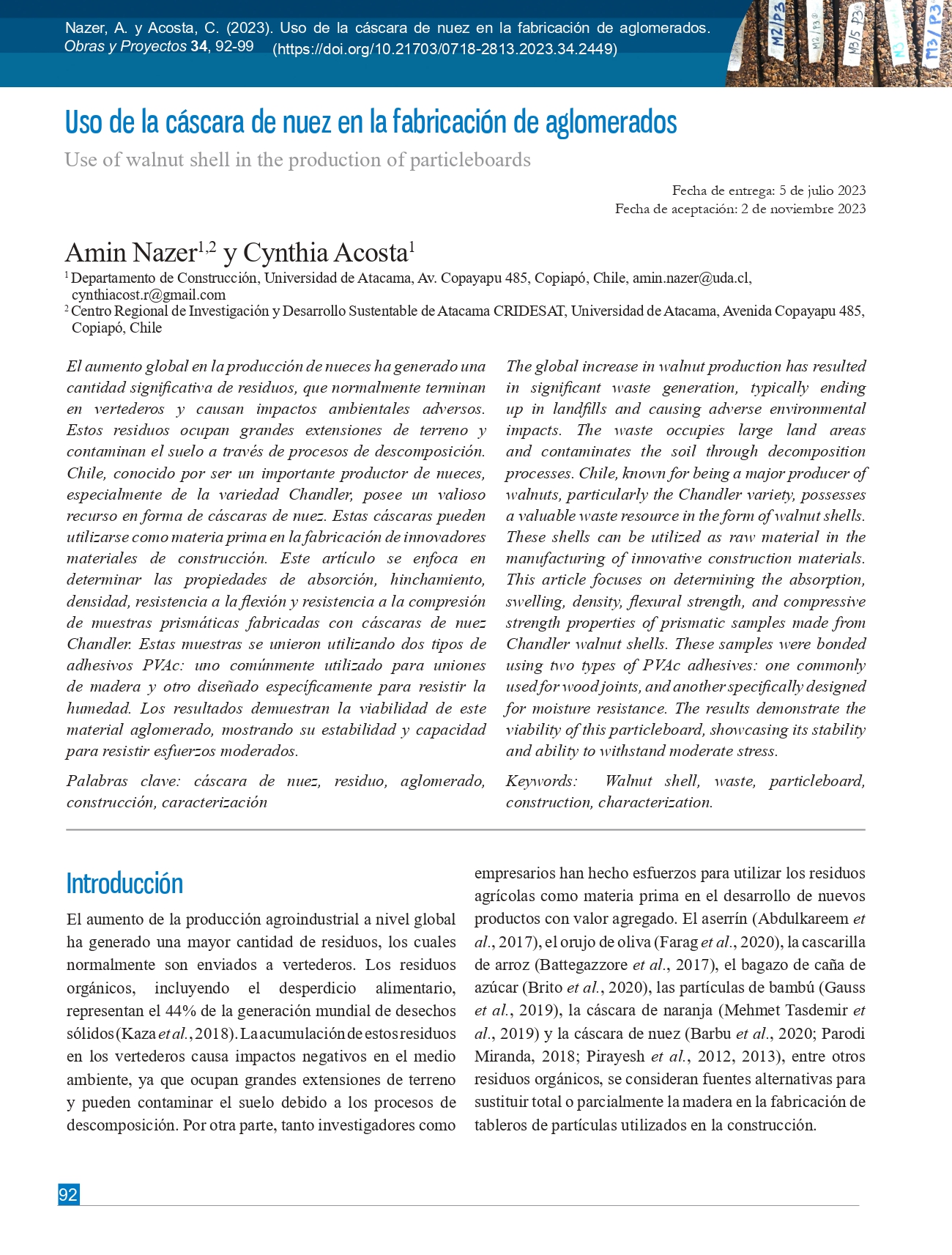Uso de la cáscara de nuez en la fabricación de aglomerados
DOI:
https://doi.org/10.21703/0718-2813.2023.34.2449Palabras clave:
Cáscara de nuez, Residuo, Aglomerado, Construcción, CaracterizaciónResumen
El aumento global en la producción de nueces ha generado una cantidad significativa de residuos, que normalmente terminan en vertederos y causan impactos ambientales adversos. Estos residuos ocupan grandes extensiones de terreno y contaminan el suelo a través de procesos de descomposición. Chile, conocido por ser un importante productor de nueces, especialmente de la variedad Chandler, posee un valioso recurso en forma de cáscaras de nuez. Estas cáscaras pueden utilizarse como materia prima en la fabricación de innovadores materiales de construcción. Este artículo se enfoca en determinar las propiedades de absorción, hinchamiento, densidad, resistencia a la flexión y resistencia a la compresión de muestras prismáticas fabricadas con cáscaras de nuez Chandler. Estas muestras se unieron utilizando dos tipos de adhesivos PVAc: uno comúnmente utilizado para uniones de madera y otro diseñado específicamente para resistir la humedad. Los resultados demuestran la viabilidad de este material aglomerado, mostrando su estabilidad y capacidad para resistir esfuerzos moderados.
Referencias
Abdulkareem, S.A., Raji, S.A. and Adeniyi, A.G. (2017). Development of particleboard from waste styrofoam and sawdust. Nigerian Journal of Technological Development 14(1), 18-22.
ASTM D1037 (1999). Standard test methods for evaluating properties of wood-based fiber and particle materials. American Society of Testing and Materials, West Conshohocken, PA, USA.
Barbu, M.C., Sepperer, T., Tudor, E.M. and Petutschnigg, A. (2020). Walnut and hazelnut shells: untapped industrial resources and their suitability in lignocellulosic composites. Applied Sciences 10(18), 6340.
Battegazzore, D., Alongi, J., Frache, A., Wågberg, L. and Carosio, F. (2017). Layer by layer-functionalized rice husk particles: A novel and sustainable solution for particleboard production. Materials Today Communications 13, 92–101.
Brito, F.M.S., Bortoletto Júnior, G., Paes, J.B., Belini, U.L. and Tomazello-Filho, M. (2020). Technological characterization of particleboards made with sugarcane bagasse and bamboo culm particles. Construction and Building Materials 262, 120501.
ECHA (2018). Formaldehyde and formaldehyde releasers- Strategy for future work. European Chemicals Agency ECHA, Helsinki, Finland.
FAO. (2019). Estadísticas de productos forestales. Organización de las Naciones Unidas para la Alimentación y la Agricultura, Roma, Italia.
FAO (2020). Cultivos. Nueces con cáscara. Organización de las Naciones Unidas para la Alimentación y la Agricultura, Roma, Italia.
Farag, E., Alshebani, M., Elhrari, W., Klash, A. and Shebani, A. (2020). Production of particleboard using olive stone waste for interior design. Journal of Building Engineering 29, 101119.
Frihart, C. (2012). Wood adhesion and adhesives. Handbook of Wood Chemistry and Wood Composites, R.M. Rowell (ed.), 2nd ed., Boca Raton, FL, USA, CRC Press, 255–320.
Gauss, C., de Araujo, V., Gava, M., Cortez-Barbosa, J. and Junior, H.S. (2019). Bamboo particleboards: Recent developments. Pesquisa Agropecuária Tropical 49, e55081.
Gürü, M., Atar, M. and Yildirim, R. (2008). Production of polymer matrix composite particleboard from walnut shell and improvement of its requirements. Materials & Design 29(1), 284–287.
Hilal, N., Mohammed Ali, T.K. and Tayeh, B.A. (2020). Properties of environmental concrete that contains crushed walnut shell as partial replacement for aggregates. Arabian Journal of Geosciences 13(16), 812.
Kaza, S., Yao, L., Bhada-Tata, P. and Van Woerden, F. (2018). What a waste 2.0. A global snapshot of solid waste management to 2050. International Bank for Reconstruction and Development. The World Bank, Washington DC, USA.
Kowaluk, G. and Fuczek, D. (2009). PVAc glue as a binding agent in particleboards. Drewno 52(182), 17–24.
Martínez, M.L., Moiraghi, L., Agnese, M. and Guzman, C. (2003). Making and some properties of activated carbon produced from agricultural industrial residues from Argentina. The Journal of the Argentine Chemical Society 91(4–6), 103–108.
Mehmet Tasdemir, H., Sahin, A., Karabulut, A.F. and Guru, M. (2019). Production of useful composite particleboard from waste orange peel. Cellulose Chemistry and Technology 53(6), 517–526.
Orue, A., Eceiza, A. and Arbelaiz, A. (2020). The use of alkali treated walnut shells as filler in plasticized poly (lactic acid) matrix composites. Industrial Crops and Products 145, 111993.
Parodi Miranda, D. (2018). Material compuesto a partir del residuo cáscara de nuez Juglans regia. Revista Chilena de Diseño: Creación y Pensamiento 3(5), 1–13.
Pirayesh, H., Khanjanzadeh, H. and Salari, A. (2013). Effect of using walnut/almond shells on the physical, mechanical properties and formaldehyde emission of particleboard. Composites Part B: Engineering 45(1), 858–863.
Pirayesh, H., Khazaeian, A. and Tabarsa, T. (2012). The potential for using walnut (Juglans regia L.) shell as a raw material for wood-based particleboard manufacturing. Composites Part B: Engineering 43(8), 3276–3280.
Portalfrutícola (2017). https://www.portalfruticola.com/noticias/2019/09/27/guia-varietal-de-nueces-imagenes-ycaracteristicas/
Queirós, C.S.G.P., Cardoso, S., Lourenço, A., Ferreira, J., Miranda, I., Lourenço, M. J. V. and Pereira, H. (2020). Characterization of walnut, almond, and pine nut shells regarding chemical composition and extract composition. Biomass Conversion and Biorefinery 10(1), 175–188.
Shah, A.H., Li, X., Xu, X.D., Wang, S., Bai, J.W., Wang, J. and Liu, W.B. (2018). Effect of alkali treated walnut shell (Juglans regia) on high performance thermosets. Study of curing behavior, thermal and thermomechanical properties. Digest Journal of Nanomaterials and Biostructures 13(3), 857–873.
Solt, P., Konnerth, J., Gindl-Altmutter, W., Kantner, W., Moser, J., Mitter, R. and van Herwijnen, H. W.G. (2019). Technological performance of formaldehyde-free adhesive alternatives for particleboard industry. International Journal of Adhesion and Adhesives 94, 99–131.
Stefanowski, B.K., Curling, S.F. and Ormondroyd, G.A. (2017). Assessment of lignocellulosic nut wastes as an absorbent for gaseous formaldehyde. Industrial Crops and Products 98, 25–28.
Trischler, J. and Sandberg, D. (2014). Monocotyledons in particleboard production: Adhesives, additives, and surface modification of reed canary grass. BioResources 9(3), 3919–3938.
Velasco, J. (2018). Cómo llegar a las 200 mil toneladas de nueces. En Nogales y otros frutales de nuez. Redagrícola.com Warcok, F. (2007). Nowe trendy w produkcji srodkow wiazacych w swietle wymagan Unii Europejskiej dotyczacych emisji formaldehydu. Biul. Inf. Ośrodka Badaw. Przem. Płyt Drewnopochodnych w Czarnej Wodzie, 47(1–2), 35-42 (en Polaco).

Descargas
Publicado
Número
Sección
Licencia

Esta obra está bajo una licencia internacional Creative Commons Atribución-NoComercial 4.0.







